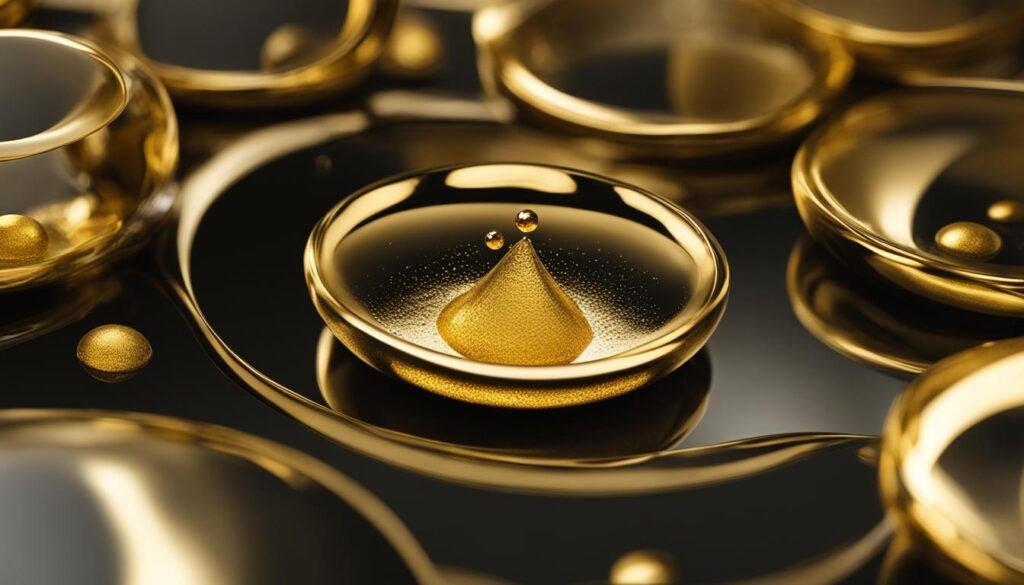Fake gold is a term used to describe materials that imitate the appearance of real gold. These materials are often used in the production of fake gold jewelry and other items. It is important to understand the composition of fake gold to avoid being deceived and ensure the authenticity of gold items.
Fake gold can be made of various components, including:
- Base metals: Fake gold often contains base metals such as copper, brass, or zinc, which are mixed with other materials to achieve a gold-like appearance.
- Alloys: Some fake gold may be composed of alloys, which are combinations of different metals. These alloys are carefully crafted to mimic the color and shine of real gold.
- Gold plating: In some cases, fake gold items are simply gold-plated. This means that a thin layer of real gold is applied to the surface of the item, giving it the appearance of being made entirely of gold.
Understanding the materials used in fake gold is essential for identifying and distinguishing between real gold and imitation gold. By familiarizing yourself with the composition of fake gold, you can make more informed decisions when purchasing gold items.
Key Takeaways:
- Fake gold is composed of various materials that imitate the appearance of real gold.
- Common components of fake gold include base metals, alloys, and gold plating.
- Familiarizing yourself with the composition of fake gold can help you identify and differentiate between real and imitation gold.
Real Gold vs Fake Gold: Understanding the Difference
When it comes to determining the authenticity of gold items, being able to differentiate between real gold and fake gold is crucial. While it may seem challenging at first, understanding the differences between these two types of gold is essential. Real gold is classified based on its purity, measured in karats, while fake gold is made of various metals and alloys that resemble gold. Let’s explore how to tell real gold from fake gold and identify authentic gold items.
Real Gold: The Pinnacle of Purity
Real gold, also known as genuine or pure gold, is composed solely of the precious metal itself. It is classified by its purity, which is measured in karats. The higher the karat rating, the purer the gold. Pure gold is considered to be 24 karats, meaning it is 99.9% gold.
- Key characteristic of real gold: High purity and consistent yellow-orange color.
Fake Gold: The Imposter
Fake gold, on the other hand, is made of various metals and alloys that resemble gold but do not contain the same level of purity. These materials, such as copper, brass, or other base metals, are often mixed with a small amount of gold to create the illusion of gold.
- Key characteristics of fake gold: May have variations in color, lack of consistent luster, or a magnetic response.
To determine if an item is real gold or fake gold, it is important to consider multiple factors and perform various tests. Each test provides valuable insights into the authenticity of the gold item.
Remember: fake gold cannot match the purity and consistency of real gold.
Contrasting Real Gold and Fake Gold
| Real Gold | Fake Gold | |
|---|---|---|
| Composition | Pure gold (99.9% gold) | Mix of metals and alloys with a small amount of gold |
| Purity | Measured in karats, starting from 24 karats | Lower purity compared to real gold |
| Color and Luster | Consistent yellow-orange color and vibrant luster | May have variations in color and lack a distinctive luster |
| Magnetic Response | Not magnetic | May exhibit a magnetic response due to metal alloys |
As shown in the table above, real gold and fake gold have distinct differences in their composition, purity, color, luster, and magnetic response. Understanding these distinctions is crucial in identifying authentic gold items and avoiding the risk of purchasing fake gold.
Through visual inspections, hallmark examinations, physical tests, and professional testing methods, it is possible to determine the authenticity and purity of gold items. In the upcoming sections, we will explore these testing methods in detail, providing you with the knowledge and tools to identify real gold from its imitations.
Types of Fake Gold
When it comes to fake gold, there are various types that you need to be aware of. Understanding these types can help you identify fake gold and make informed purchasing decisions. The most common types of fake gold found in the market include:
- Gold-plated jewelry: This type of fake gold has a thin layer of gold applied to the surface. It is created by electroplating a thin layer of gold onto a base metal such as copper or brass. Gold-plated jewelry often gives the appearance of real gold but lacks the durability and value of solid gold.
- Gold-filled jewelry: Unlike gold-plated jewelry, gold-filled jewelry has a thicker layer of gold. It is created by bonding a layer of gold to a base metal using heat and pressure. Gold-filled jewelry offers better quality and durability compared to gold-plated jewelry. However, it still contains less gold content compared to solid gold.
- Jewelry made from copper or brass: Some fake gold items are made from copper or brass but are designed to resemble gold. These pieces are often coated with a thin layer of gold or sprayed with gold paint to enhance their appearance.
- Pyrite: Pyrite, also known as “fool’s gold,” is a mineral that naturally forms with a golden color. It can be easily mistaken for real gold due to its similar appearance. However, pyrite is much lighter and less valuable than gold.
It is important to note that while these types of fake gold may look convincing at first glance, they do not possess the same value or properties as real gold. Being able to identify these types of fake gold can help you avoid scams and make educated choices when purchasing gold.

Comparing Types of Fake Gold
| Type of Fake Gold | Gold Content | Durability | Value |
|---|---|---|---|
| Gold-plated jewelry | Thin layer | Less durable | Lower value |
| Gold-filled jewelry | Thicker layer | More durable | Moderate value |
| Jewelry made from copper or brass | Coated or painted | Less durable | Lower value |
| Pyrite | Not gold | Less durable | Low value |
Gold Purity in Karats
When it comes to determining the purity of gold, karat ratings play a significant role. Gold purity is measured in karats, with 24 karat representing pure gold. The karat rating indicates the amount of gold present in a particular item, while the remaining portion consists of other metals.
Understanding karat ratings is essential for anyone looking to purchase gold items. The lower the karat rating, the lower the gold content, and the higher the presence of other metals. For example, 18 karat gold contains 75% gold and 25% other metals, while 14 karat gold contains 58.3% gold and 41.7% other metals.
Here is a handy guide to help you navigate gold purity in karats:
| Karat Rating | Gold Content | Other Metal Content |
|---|---|---|
| 24K | 99.9% | Negligible |
| 22K | 91.7% | 8.3% |
| 18K | 75% | 25% |
| 14K | 58.3% | 41.7% |
| 10K | 41.7% | 58.3% |
As you can see, the higher the karat rating, the purer the gold. However, it’s worth noting that higher karat gold is also more malleable and prone to scratching compared to lower karat gold, which is often alloyed with stronger metals for added durability.
So, whether you’re buying jewelry or investing in gold, understanding the karat ratings will help you make informed decisions and ensure you’re getting the purity of gold that aligns with your needs and preferences.
Testing Gold Purity
When it comes to determining the purity of gold, there are several methods available that range from simple and inexpensive tests to more complex and accurate ones. By utilizing a combination of these tests, you can ensure accurate results and make informed decisions when buying or selling gold.
- The Visual Inspection test involves examining the color, luster, and appearance of the gold. Real gold has a distinct yellow-orange hue and exhibits a consistent shine. Any variations in color or inconsistencies in luster may indicate the presence of other metals or alloys, suggesting that the item may not be genuine gold.
- The Hallmark Examination test utilizes the hallmarks stamped on gold items to verify their purity and authenticity. These hallmarks provide information about the gold’s karat rating and other relevant details. Although it is a useful method, it’s important to exercise caution as counterfeit hallmarks can be used to deceive buyers.
- The Touch Test involves holding the gold item and observing how it reacts to your skin. Real gold is nonreactive and won’t cause any discoloration or irritation. If you notice any green or black markings on your skin after touching the gold, it may indicate the presence of other metals.
- The Scratch Test requires rubbing the gold item against unglazed ceramic to assess its authenticity. Real gold is relatively soft and should leave a golden streak on the ceramic surface. If the streak is black or any other color, it suggests that the gold may be fake or heavily alloyed.
- The Weight Comparison test involves comparing the weight of the gold item with a known piece of gold of the same size and purity. Real gold has a specific density, so any significant deviations in weight may indicate impurities or counterfeit gold.
- The Magnetic Test is a simple yet effective method to determine gold purity. Real gold is not magnetic, so if the gold item is attracted to a magnet, it likely contains other metals or is counterfeit.
- The Water Test utilizes the principle of density to determine the authenticity of gold. Since gold is denser than most other metals, it will sink in water. If the gold floats or remains suspended, it may not be genuine gold.
- The Chemical Test involves using substances like vinegar or nitric acid to assess the gold’s authenticity. Real gold does not react with vinegar or nitric acid, while other metals may produce a visible reaction, indicating the presence of impurities.
- Lastly, seeking Professional Testing from trained jewelers or appraisers is always a valuable option. They have access to advanced testing equipment like the Sigma Metalytics Precious Metal Verifier and XRF Spectrometer, which provide accurate results regarding gold purity.
It is important to note that using multiple tests is highly recommended to ensure accurate and reliable results. Each method has its limitations, and combining them enhances the overall evaluation of gold purity.

Visual Inspections
When it comes to identifying real gold, visual inspections play a crucial role. By examining the color, luster, and overall appearance of the item, you can gather valuable clues about its authenticity. Genuine gold has a distinct yellow-orange hue that sets it apart from other metals.
One of the visual signs of real gold is its consistent and radiant luster. Gold possesses a unique shine that remains uniform across the entire surface. Any variations or dullness in luster may indicate the presence of other metals or alloys, suggesting that the item in question is not genuine gold.
To help you understand the visual signs of real gold more effectively, refer to the image below:
| Real Gold | Fake Gold |
|---|---|
| Distinct yellow-orange color | Inconsistent or unnatural color |
| Consistent and radiant luster | Variations or dullness in luster |
Table: Visual Signs of Real Gold vs Fake Gold
Hallmark Examinations
Gold items often bear hallmarks that serve as indicators of their purity and authenticity. When examining gold hallmarks, one can gain valuable insight into the karat rating and other relevant information about the gold item. However, it is essential to approach hallmark examinations with caution, as counterfeit hallmarks can be used to deceive buyers.
Hallmarks, typically stamped onto gold items, are small markings that represent important details such as the manufacturer, the purity of the gold, and the country of origin. These markings provide a standardized system for identifying and verifying the authenticity of gold.
There are various types of hallmarks used to signify different characteristics of gold. For example, the karat hallmark indicates the gold’s purity level, ranging from 9k to 24k, with 24k being pure gold.
When interpreting gold hallmarks, it is crucial to understand the different symbols and codes associated with hallmarks specific to each country or region. For instance, the crown and fineness symbolize British hallmarks, while the eagle or the sun can represent hallmarks from other countries.
To ensure the accuracy of hallmark interpretations, it is advisable to consult reputable resources such as databases or reference books on gold hallmarks specific to the respective country or region. These resources provide comprehensive guides, enabling individuals to identify genuine hallmarks and differentiate them from fake ones.
In cases where individuals are unsure about the authenticity of a gold item’s hallmark, seeking the assistance of a professional appraiser or jeweler is highly recommended. These experts have the necessary expertise and magnification tools to thoroughly examine hallmarks and provide accurate assessments of gold items.
Benefits of Hallmark Examinations:
- Provide insights into the gold item’s purity and authenticity
- Help identify the country or region of origin
- Enable comparisons between different gold items
- Offer assurance and peace of mind for buyers
Remember, while hallmark examinations are valuable in determining the authenticity of gold items, they should be combined with other testing methods for a comprehensive assessment. By employing multiple tests, including visual inspections and physical examinations, individuals can make informed decisions when purchasing gold items.

Physical Tests
When determining the authenticity of gold, physical tests play a crucial role. These tests require direct interaction with the gold item, allowing for a more hands-on approach in assessing its legitimacy. The three main physical tests for gold include the touch test, scratch test, and weight test.
Touch Test
In the touch test, one can assess the reaction between the gold item and their skin. Real gold typically does not react with the skin, while fake gold may cause irritation or discoloration.
Scratch Test
The scratch test involves rubbing the gold item against an unglazed ceramic surface. Genuine gold will not leave any marks, indicating its resistance to scratching. However, if the gold item leaves a streak or discolors the ceramic, it may indicate that the item is not made of real gold.
Weight Test
The weight test compares the gold item to a known piece of gold of a certain purity and size. By comparing the weight of the two items, one can determine if the gold item is of similar composition and authenticity.
| Physical Test | Method | Result |
|---|---|---|
| Touch Test | Hold the gold item against the skin | No reaction or discoloration indicates real gold |
| Scratch Test | Rub the gold item against unglazed ceramic | No marks or discoloration indicate real gold |
| Weight Test | Compare the weight to a known gold piece | Similar weight indicates genuine gold |
These physical tests provide initial insights into the authenticity of a gold item. However, it is important to note that these tests are not foolproof and may require additional examination using other testing methods for a more accurate determination.
Magnet and Water Tests
When it comes to testing the authenticity of gold, two commonly used methods are the magnet test and the water test. These tests can help determine whether the gold item is genuine or if it might be fake or impure.
Magnet Test for Gold
The magnet test involves using a strong magnet to check if the gold item is attracted to it. Real gold is not magnetic, so if the item is attracted to the magnet, it indicates that it is either impure or fake.
Here’s how to perform the magnet test:
- Take a strong magnet.
- Hold it near the gold item.
- Observe if the gold is attracted to the magnet.
- If the gold is attracted to the magnet, it is likely not real gold.
| Magnet Test Results | Interpretation |
|---|---|
| The gold item is not attracted to the magnet. | The item is likely genuine gold. |
| The gold item is attracted to the magnet. | The item is either impure or fake. |
Note: The magnet test is not foolproof and may not provide definitive results. Other tests should be used in conjunction for a more accurate assessment of gold authenticity.
Water Test for Gold
The water test involves placing the gold item in water and observing its behavior. Real gold has a higher density than other metals, so it will sink to the bottom of the container.
Here’s how to conduct the water test:
- Fill a container with water.
- Gently place the gold item into the water.
- Observe whether the gold sinks or floats.
- If the gold sinks, it is likely real gold.
- If the gold floats or stays near the surface, it may be fake or impure.
| Water Test Results | Interpretation |
|---|---|
| The gold item sinks to the bottom of the water. | The item is likely genuine gold. |
| The gold item floats or stays near the surface. | The item may be fake or impure. |
Caution: The water test should be performed carefully to avoid damaging the gold item. If you are unsure or dealing with valuable gold, it is advisable to seek professional testing.

Chemical Tests
Chemical tests are an important method for determining the authenticity of gold. Two commonly used chemical tests for gold are the vinegar test and the nitric acid test. These tests help identify any presence of other metals or alloys in gold items.
The Vinegar Test: Vinegar is a simple and easily accessible substance that can be used to test the authenticity of gold. Real gold does not react with vinegar, so if a gold item shows a reaction, it suggests the presence of other metals. It is essential to exercise caution when performing this test and avoid contact with the eyes or skin.
The Nitric Acid Test: Nitric acid test kits are commonly used to determine the authenticity of gold. Nitric acid is capable of dissolving other metals but does not affect gold. By applying nitric acid to a gold item, one can determine if any reaction occurs. It is important to handle nitric acid with care as it is highly corrosive and can cause severe burns. This test is best performed by professionals who have the necessary expertise and experience.
Chemical Tests for Gold
Test Method Results Vinegar test Place gold item in vinegar If gold item reacts, presence of other metals Nitric acid test Apply nitric acid to gold item If no reaction occurs, gold is authentic
Chemical tests provide valuable insights into the composition of gold items and help in determining their authenticity. While the vinegar test can be easily performed at home, the nitric acid test should be entrusted to professionals due to its corrosive nature. By utilizing these chemical tests, individuals can make informed decisions when buying or selling gold.
Professional Testing
When it comes to determining the authenticity and purity of gold items, professional testing is the most reliable option. Seeking the expertise of a professional jeweler or appraiser who has the necessary tools and knowledge is vital in ensuring accurate results. Professional testing provides a higher level of certainty, giving you peace of mind when making important gold-related decisions.
Methods and Equipment
Professional jewelers and appraisers use specialized equipment to test gold with precision. Two commonly used methods are the Sigma Metalytics Precious Metal Verifier and the XRF Spectrometer.
The Sigma Metalytics Precious Metal Verifier is a handheld device that uses electromagnetic waves to determine the authenticity and purity of gold. It provides instant results without the need for destructive testing. By analyzing the electrical and magnetic properties of the gold, the device can distinguish between genuine gold and fake gold.
The XRF Spectrometer is a more advanced tool that uses X-ray fluorescence technology to analyze the composition of gold items. It measures the fluorescent X-rays emitted by the gold when exposed to high-energy X-rays. This non-destructive testing method provides highly accurate results, identifying not only the gold purity but also the presence of other elements.
Benefits of Professional Testing
Professional testing offers several advantages when it comes to determining gold authenticity:
- Accuracy: Professional jewelers have years of experience and expertise in testing gold, ensuring accurate results.
- Reliability: The use of specialized equipment minimizes the chances of error in the testing process.
- Confidence: By opting for professional testing, you can be confident in the authenticity and purity of your gold items.
Conclusion
Distinguishing between real gold and fake gold is crucial for anyone looking to ensure the value and authenticity of their gold items. By utilizing various testing methods, individuals can acquire the knowledge necessary to make informed purchases and avoid falling prey to scams involving fake gold. It is recommended to employ multiple tests, as no single method can provide absolute certainty.
Throughout this article, we have explored a range of testing techniques, including visual inspections, hallmark examinations, physical tests, magnet and water tests, chemical tests, and professional testing. Each method offers its own unique insights into the authenticity of gold. However, it is important to note that professional testing, conducted by an experienced jeweler or appraiser, provides the highest level of accuracy and confidence.
In conclusion, the ability to identify fake gold is an essential skill in the world of precious metals. By applying the knowledge gained from this article and employing the appropriate testing methods, individuals can confidently differentiate between real gold and its imitation counterparts. Remember, always be cautious and meticulous when evaluating gold items to ensure accurate results and protect your investment.
FAQ
What is fake gold made of?
Fake gold is made of various materials that imitate the appearance of real gold, such as metals, alloys, and minerals.
How can I tell the difference between real gold and fake gold?
Real gold is classified based on its purity measured in karats, while fake gold is made of metals and alloys that resemble gold. There are various tests available to determine the authenticity of gold items.
What are the types of fake gold?
The types of fake gold commonly found in the market include gold-plated jewelry, gold-filled jewelry, jewelry made from copper or brass, and pyrite, a mineral that resembles gold.
What are gold purity ratings?
Gold purity is measured in karats, with 24 karat representing pure gold. The lower the karat rating, the lower the gold content and the higher the presence of other metals.
How can I test the purity of gold?
There are several methods to test gold purity, including visual inspections, hallmark examinations, physical tests, magnet tests, water tests, chemical tests, and professional testing methods.
What are visual inspections for gold?
Visual inspections involve examining the color, luster, and appearance of gold. Real gold has a distinct yellow-orange color and a consistent luster.
How do hallmark examinations help determine gold authenticity?
Gold items often have hallmarks that indicate their purity and authenticity. These hallmarks can be examined to determine the karat rating and other relevant information about the gold item.
What are the physical tests for gold?
Physical tests involve directly interacting with the gold item to assess its authenticity. These tests include the touch test, scratch test, and weight test.
How can magnet and water tests determine if gold is fake?
The magnet test involves using a strong magnet to determine if the gold item is attracted to it. Real gold is not magnetic. The water test involves placing the gold item in water and observing if it sinks. Real gold has a higher density than other metals and will sink to the bottom of the container.
What are the chemical tests for gold?
Chemical tests involve using substances like vinegar and nitric acid to determine the authenticity of gold. Vinegar does not react with real gold, while nitric acid does not affect genuine gold. However, caution must be exercised when handling nitric acid.
What is professional testing for gold?
Professional testing involves seeking the expertise of a jeweler or appraiser who has the necessary tools and knowledge to accurately test gold. Methods such as the Sigma Metalytics Precious Metal Verifier and XRF Spectrometer can be used to determine the authenticity and purity of gold items.
How important is it to distinguish between real gold and fake gold?
Distinguishing between real gold and fake gold is crucial to ensure the value and authenticity of gold items. With the knowledge gained from various testing methods, individuals can make informed purchases and avoid being deceived by fake gold.



